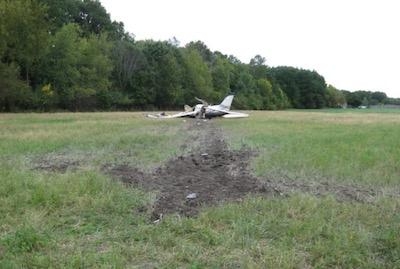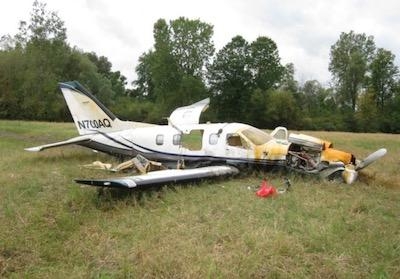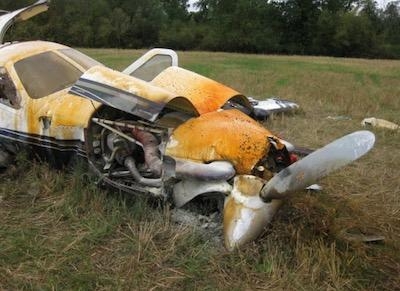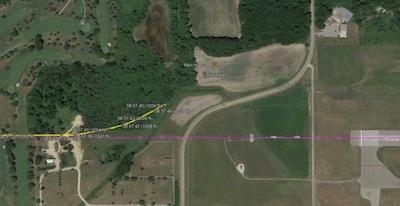Five Fatally Injured When The Aircraft Impacted Terrain
The NTSB has released its preliminary report from an accident involving a Socata TBM 700 airplane, N700AQ, which collided with terrain while on an instrument approach to Capital Region International Airport (KLAN), Lansing, Michigan on October 3.

The commercial pilot, pilot-rated passenger, and 3 passengers were fatally injured. The remaining passenger sustained serious injuries. The airplane was substantially damaged. The airplane was owned by N700AQ LLC and operated under an instrument flight rules (IFR) flight plan. Day instrument meteorological conditions prevailed at the accident site. The cross-country business flight departed Indy South Greenwood Airport (KHFY), Greenwood, Indiana, at 0800.
According to automatic dependent surveillance-broadcast (ADS-B) data that was transmitted from the airplane to FAA air traffic control (ATC), the flight departed runway 19 at KHFY and turned northeast toward MAREO intersection where it turned north toward KLAN. The airplane subsequently climbed to flight level 190 (19,000 ft pressure altitude). At 0834:24, the flight entered a cruise descent from flight level 190 and was progressively cleared down to 3,000 ft mean sea level (msl). According to ATC communications, the pilot was provided radar vectors to join the localizer for the instrument landing system (ILS) runway 10R approach at KLAN. At 0853:03, the approach controller stated, "TBM zero alpha quebec, five miles from FAMLI, turn right, ah, right heading zero seven zero, maintain three thousand until established on the localizer, cleared the ILS one zero right." The pilot responded, "Zero seven zero, ah, we're cleared for the ILS ten right into, ah, Lansing." The ADS-B data indicated the airplane
entered a right turn and joined the localizer inbound.
At 0854:27, the approach controller stated, "TBM zero alpha quebec, contact Lansing tower one one niner point niner, good day." The pilot responded, "One nineteen ninety, seven hundred alpha quebec." At 0855:29, the airplane crossed over the outer marker (FAMLI) at 2,302 ft msl and continued to descend on the glideslope while established inbound on the localizer toward runway 10R. The airplane had a calculated true airspeed of 168 knots when it crossed over the outer marker. Between 0855:29 and 0857:45, the airplane continued to decelerate from 168 knots to 64 knots.
At 0854:36, the pilot established contact with the Lansing tower controller and reported being established on the ILS Runway 10R instrument approach. At 0854:39, the tower controller stated, "Seven zero zero alpha quebec, Lansing, ah, tower, the winds are calm, one zero right cleared to land." The pilot responded, "Cleared to land, ah, ten right, seven hundred alpha quebec." There were no additional communications received from the pilot. At 0858:13, the tower controller attempted to contact the pilot over the tower frequency without success.
The ADS-B data indicated that at 0857:06 the airplane was about 1.3 miles from the runway threshold at 1,250 ft msl (about 400 ft above the runway elevation) and established on the localizer inbound to the runway. At 0857:37, the airplane was 0.5 mile from the runway threshold at 1,041 ft msl (about 180 ft above the runway elevation) when it entered a shallow climb and a left turn away from the runway heading. When the left turn began, the airplane had decelerated to 72 knots. Between 0857:37 and 0857:45, the airplane continued to decelerate to 64 knots while it climbed to 1,059 ft. At 0857:45, the final ADS-B datapoint was located about 300 ft north of the localizer centerline and 0.36 miles from the runway 10R threshold. The final ADS-B datapoint was about 480 ft southwest of the initial impact point with terrain.
According to FAA records, the 48-year-old pilot held a commercial pilot certificate with single-engine land and instrument airplane ratings. His most recent FAA second-class medical certificate was issued on January 4, 2019, with no restrictions or limitations. On the application for his current medical certificate, the pilot reported having accumulated 1,325 total hours of flight experience and 125 hours within the previous 6 months.
The pilot's flight history was established using his logbook. The final logbook entry was dated September 30, 2019, at which time he had accumulated 1,403.8 hours total flight time. The pilot had 1,404.8 hours total flight experience including the 1 hour accident flight. The pilot had flown 1,375 hours in single-engine airplanes and 29.8 hours multi-engine airplanes. He had logged 1,365 hours as pilot-in-command, all of which were flown in single-engine airplanes. He had flown 250.6 hours, 125.9 hours, 88.2 hours, and 35.5 hours during the year, 6 months, 90 days, and month before the accident, respectively. Based on available information, the 1 hour accident flight was his only flight time during the previous 24 hours.

The pilot's most recent flight review, as required by Title 14 CFR 61.56, was completed upon the issuance of his commercial pilot certificate dated May 8, 2019. His last instrument proficiency check was completed in a Redbird SR22 simulator on September 12, 2019. He completed the SIMCOM TBM 700 Initial Course on September 30, 2018. According to the pilot's logbook, he had flown 76.4 hours and 9.8 hours in Socata TBM 700 and TBM 850 airplanes, respectively. The pilot had logged all of his Socata TBM 700 flight time during the 12 months before the accident.
According to FAA records, the 67-year-old pilot-rated passenger held a commercial pilot certificate with single-engine land and instrument airplane ratings. He also held a flight instructor certificate for single-engine land and instrument. The pilot did not possess a valid FAA medical certificate; his previous third-class medical certificate expired on August 31, 2017. The pilot obtained the required comprehensive medical examination for BasicMed from his physician on September 25, 2017, and completed the required medical education course on February 19, 2018. A pilot logbook was not located during the onsite investigation.
The airplane, a Socata TBM 700 C2, serial number 252, was manufactured in 2003. The low-wing airplane was of conventional aluminum construction and was equipped with a retractable tricycle landing gear and a pressurized cabin that was configured to seat six individuals. The airplane was powered by a 700 shaft-horsepower Pratt & Whitney Canada PT6A-64 turbo-propeller engine, serial number PCE-PM-0140, through a 4-blade, constant speed, full-feathering, Hartzell HC-E4N-3/E9083SK propeller assembly, serial number HH1456. The airplane was approved for operations in instrument meteorological conditions and in known icing conditions. The airplane had a maximum allowable takeoff weight of 7,394 pounds. On May 12, 2003, the airplane was issued a standard airworthiness certificate and a registration number when it was imported into the United States after manufacture in France. The current airplane owner purchased the airplane on July 31, 2018.
According to maintenance records, the airplane had been maintained under the provisions of an approved manufacturer inspection program. The most recent annual inspection was completed on June 1, 2019, at 3,512.3 hours total airframe time. At the time of the accident, the airframe, engine, and propeller had accumulated 3,550.6 hours since new. The engine had accumulated 1,184.8 hours since its last hot section inspection. The propeller had accumulated 1,089.4 hours since its last overhaul. The static system, altimeter system, automatic pressure altitude reporting system, and transponder were last tested on April 10, 2018. A postaccident review of the available maintenance records found no history of unresolved airworthiness issues.
The airplane had two fuel tanks, one located in each wing, and a total fuel capacity of 290.6 gallons (281.6 gallons usable). The airplane had been fueled with 100 gallons of fuel before the flight, and according to available fueling documentation and airplane use logs, the airplane had about 202 gallons onboard before the flight.
According to the current weight-and-balance record, dated May 24, 2017, the airplane had an empty weight of 4,674.28 lbs and a useful load of 2,719.92 lbs. The empty weight center-of-gravity (CG) was 187.17 inches aft of the datum. At maximum takeoff weight, 7,394 lbs, the forward and aft CG limits were 187 inches and 193.65 inches, respectively.

The airplane's weight and balance at takeoff were calculated using the reported weights and seat positions for the pilot and the 5 passengers, fueling receipts/invoices, and recent flight tracking data. Based on the available data, the takeoff weight and CG location were estimated to be 7,626.28 lbs and 196.18 inches, respectively. At takeoff, the airplane was about 232 lbs over the maximum allowable takeoff weight and about 2.53 inches past the aft CG limit. The engine burned about 70 gallons (476 lbs) of fuel during the flight. The estimated airplane weight and CG location at the time of impact were 7,150.28 lbs and 196.60 inches, respectively. At impact, the airplane was about 126 lbs over the maximum allowable landing weight and 2.95 inches past the aft CG limit.
According to the Socata TBM 700 C2 Pilot Operating Handbook (POH), Supplement No. 41, the aerodynamic stall speed at maximum takeoff weight with the landing gear and flaps extended for landing is 65 knots. The aerodynamic stall speed at maximum takeoff weight with the landing gear and flaps extended for takeoff is 77 knots. The aerodynamic stall speed at maximum takeoff weight with the landing gear and flaps retracted is 83 knots. The approach speed with flaps in the landing position is 85 knots.
A postaccident review of available meteorological data established that day instrument meteorological conditions prevailed at the accident site. At 0853, about 5 minutes before the accident, the KLAN automated surface observing system reported a calm wind, 1.25 miles surface visibility, light rain with mist, 400 ft above ground level (agl) overcast ceiling, temperature 12°C, dew point 11°C, and an altimeter setting of 29.93 inches of mercury. At 0906, about 8 minutes after the accident, the KLAN automated surface observing system reported a calm wind, 1 mile surface visibility, light rain with mist, a vertical visibility of 500 ft agl, temperature 12°C, dew point 12°C, and an altimeter setting of 29.94 inches of mercury.
Capital Region International Airport, a public airport located about 3 miles northwest of Lansing, Michigan, was owned and operated by Capital Region Airport Authority. The airport field elevation was 861 ft msl. The airport was served by three asphalt runways, runway 10R/28L (8,506 ft by 150 ft), runway 6/24 (5,003 ft by 120 ft), and runway 10R/28L (8,506 ft by 150 ft), runway 10L/28R (3,601 ft by 75 ft). The airport was equipped with an air traffic control tower that was operational at the time of the accident.
During an ILS approach, the localizer provides lateral guidance for the final approach course, and the glideslope provides vertical guidance as the aircraft descends toward the runway. For a precision approach, such as an ILS approach, the missed approach point is where the aircraft reaches the decision altitude while on the glideslope.

The published inbound course for the ILS runway 10R approach at KLAN was 096° magnetic, the crossing altitude for the final approach fix (FAMLI) was 2,367 ft msl, and the distance between FAMLI and the runway 10R threshold was 4.5 nm. The touchdown zone elevation was 861 ft msl. The decision altitude was 1,061 ft msl (200 ft agl) and required 2,400 ft runway visibility range (RVR). The missed approach procedure was to climb on runway heading to 2,000 ft msl, then make a left turn to a 070° magnetic heading and climb to 2,700 ft msl, then join the 257° radial from the Flint vortac, and hold at ERRYS intersection.
The initial impact was in an open grass field located about 0.3 miles west-northwest of the runway 10R threshold. The initial impact was identified by a large area of grass that had been pushed down and preceded a 135 ft long ground scar that was oriented on a 060° bearing. The initial impact point measured 42 ft wide and was consistent with the wingspan of the airplane. The lower VHF antenna, the left main landing gear door, and several flap track fairings had separated from the airplane and were located along the wreckage debris path.
The main wreckage consisted of the entire airplane. Both wings and the empennage remained attached to the fuselage. All flight control surfaces remained attached to their respective hinges. Flight control continuity for the elevator, rudder, and right aileron were confirmed from the forward cabin to each flight control surface. Flight control continuity to the left aileron could not be established due to impact damage; however, the observed cable separations near the left wing root were consistent with overstress. Both spoilers were retracted and remained connected to their respective ailerons. The wing flap actuator jack screws were found halfway between the takeoff and landing positions. The left main landing gear and nose gear were fully retracted and on their respective actuator up-locks. The right main landing gear had retracted into its wheel well; however, the right gear was not secured by its respective actuator up-lock. Both the rudder and elevator trim surfaces were found in a neutral
position. The throttle was found in the flight idle position, the propeller lever was full forward, and the condition lever was full forward. The fuel manual override was closed and gated. The flap selector was found in the "UP" and locked position. The landing gear selector switch was found in the "UP" position. The fuel system switch was found on "AUTO" and the engine was using fuel from the left fuel tank at impact. Both fuel tanks had ruptured during impact and there was a strong odor of Jet-A aviation fuel at the accident site.
The engine remained attached to its respective engine mounts. There was a complete fracture of the propeller shaft and reduction gearbox housing forward of the 2nd stage reduction gears. Engine oil was found on the outside of the engine cowling, windscreen, and extending 20 ft in front of the engine on the ground. Much of the engine oil had been pumped out of the engine after impact. There was compressive impact damage to the exhaust case at the 6 o'clock position. Engine control continuity was established from the cockpit to the fuel control unit. The propeller speed setting lever and reset cables had separated from the propeller governor; however, free movement of the cables were observed when the cockpit levers were moved by hand. The compressor rotor was free to turn with no anomalies and continuity was established with the accessory gearbox. Fuel discharged from hoses when the fuel pump was rotated. The fuel filter bowl was about ½ full of fuel, which appeared clear with no significant
debris or phase separation. Both magnetic chip detectors were free of any metallic particles. There was some minor foreign object debris found on the leading edge of several 1st stage compressor blades, and there was vegetation debris found in the inlet screen. The compressor turbine (CT) and power turbine (PT) were intact with all blades present. There were rotational contact signatures observed on the CT blades downstream platforms from contact with the inner shroud of the upstream side of the 1st stage PT vane ring. The 1st stage PT blade tips displayed rubbing, and corresponding rubbing was observed on the shroud at the 6 and 12 o'clock positions. Some of the upstream blade platforms displayed rubbing with the inner shroud of the downstream side of the 1st stage PT vane ring.
The propeller assembly remained attached to the engine propeller shaft that fractured from the engine reduction gear box during impact. One propeller blade was bent in the forward/thrust direction. The remaining three propeller blades were bent in the aft direction. All four propeller blades exhibited chordwise/rotational scoring on the camber side with paint discoloration from the tip to the outboard end of the deice boot. Three blades exhibited chordwise/rotational scoring on the face side. The spinner dome was dented adjacent to one propeller blade with a counterweight impression area with the center/average angle of about 44°. The pitch change rod was in the feathered position. Three propeller blades could be rotated by hand force due to fractured pitch change mechanisms. One propeller blade had been forcefully rotated beyond the reverse stop position, two blades were in an approximate low pitch position, and one blade was in an approximate feathered position. The beta ring appeared intact and
undamaged with the carbon block and beta arm in position. The beta arm and valve moved freely.
(Images provided with NTSB preliminary report)
 ANN's Daily Aero-Term (04.24.24): Runway Lead-in Light System
ANN's Daily Aero-Term (04.24.24): Runway Lead-in Light System ANN's Daily Aero-Linx (04.24.24)
ANN's Daily Aero-Linx (04.24.24) Aero-FAQ: Dave Juwel's Aviation Marketing Stories -- ITBOA BNITBOB
Aero-FAQ: Dave Juwel's Aviation Marketing Stories -- ITBOA BNITBOB Classic Aero-TV: Best Seat in The House -- 'Inside' The AeroShell Aerobatic Team
Classic Aero-TV: Best Seat in The House -- 'Inside' The AeroShell Aerobatic Team Airborne Affordable Flyers 04.18.24: CarbonCub UL, Fisher, Affordable Flyer Expo
Airborne Affordable Flyers 04.18.24: CarbonCub UL, Fisher, Affordable Flyer Expo






